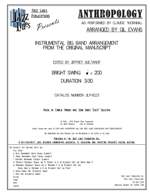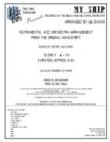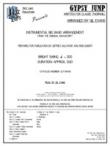ANTHROPOLOGY [DOWNLOAD]
Recorded by Claude Thornhill
Arranged by Gil Evans, Prepared by Jeffrey Sultanof

Cat #: JLP-8123-DL
$75.00This product is available for immediate download after purchase.
Questions?
Please call +1-518-587-1102 or email us.
Edition: Jazz Big Band Arrangement
Description: Swing - Difficult
Publisher: Jazz Lines Publications
Background:
Before World War II, the Claude Thornhill Orchestra's popularity was as a 'sweet' band. With the integrated sound of clarinets, saxes, trumpets, French horns, trombones and rhythm section playing under the leader's virtuosic piano solos, and the arrangements of the leader, Gil Evans and some others, the band made some beautiful recordings and was fairly successful. After a short stint in the Navy, Thornhill laid low for awhile until he put his band back together in 1946. This ensemble would become legendary as composer/arranger Gil Evans' personal workshop, as Thornhill virtually gave the band to him to do as he pleased. While Evans understood that this was still an ensemble that played popular music (and Evans certainly wrote his share of dreamy, lovely ballads and medleys), he not only gave writing opportunities to Gerry Mulligan (whom Evans mentored after the saxophonist/arranger left Gene Krupa) and George Russell (who was starting to formulate what would be his Lydian Chromatic Concept), but Evans explored the new world of modern jazz called 'bebop.' The results were the legendary trilogy of settings for Anthropology, Donna Lee, and Yardbird Suite. Most of the Thornhill musicians had little experience playing the new music, so Evans taught it to them. Thornhill was not pleased by these pieces and they were not played when he was on the stand, although he recorded the first two titles a few times. Thornhill and Evans parted musical company in early 1948, and later that year, Mulligan, Russell, Johnny Mandel, John Carisi and John Lewis joined with Gil to create a smaller ensemble that would sound like the Thornhill band. Thus was born the Miles Davis Nonet.
The Music:
Anthropology was written by Charlie Parker and Dizzy Gillespie. Evans arranged the line in 1947, and it was recorded for Columbia Records and for radio transcriptions. The instrumentation calls for 5 saxophones doubling clarinet, 3 trumpets, 2 trombones, 2 French horns, tuba, guitar, piano, bass, and drums. For this publication, the French horn and tuba parts alternately may be played by a 4th trumpet and trombones 3 and 4 as follows:
Conductors are strongly urged not to double these parts; if you have both French horns and Tuba, do not use the trumpet and trombone parts.
As with Yardbird Suite, Evans notated swing rhythms as dotted-eighth & sixteenth, not two eighths. This figure has been changed in this publication to two eighths for ease of reading.
Bars 129 to 141 were later extracted and re-orchestrated for what was probably an experiment by Evans to test out different ways of scoring these bars for the Miles Davis Nonet. Though the parts have the name Anthropology written at the top, the piece is not quoted directly. These bars were later used as a theme for the two extant broadcasts of the Nonet from the Royal Roost.
Notes to the Conductor:
The first time I heard this treatment of the Parker/Gillespie line, I laughed because Evans used one of the trademark colors of the Thornhill ensemble (clarinets, alto saxes and cup-muted trumpets) and applied it for a modern jazz theme. This would have been the last group of instruments that most arrangers would use on such a theme, but as Miles Davis said, "That's Gil for you."
This arrangement simply doesn't work when played slower than quarter note = 200, so the altos, clarinets and trumpets not only have to practice their parts to play the music smoothly, but should practice together to get the best blend possible. As you know, unisons are often problematic when instrumental color and wide melodic contours are present, and are additionally challenging given that the clarinets are in the key of A, and the alto saxes in E!
From bar 105 through bar 141, the ensemble has a huge challenge: to play the figures together without dragging and to maintain accurate intonation in the concert key of G Major. Sectional rehearsals with this section played VERY slowly at first are a must. If you have any interest in performing music from any of the Davis/Evans settings for Columbia Records, this is an example of the many minefields that are present (think of Springsville from Miles Ahead). Also observe the subtle use of dynamics as indicated by Evans.
As I have experienced with my students ensembles, mastery of this difficult music is cause for celebration, and the more you play it, the more relaxed it will sound.
-Jeffrey Sultanof (Editor)
Ranges:
- Trumpet 1: G#5
- Trombone 1: F#4
Note: The sound sample is courtesy of the Manhattan School of Music's Concert Jazz Band, conducted by Justin DiCioccio.
Reed 1: Clarinet/Alto Saxophone
Reed 2: Clarinet/Alto Saxophone
Reed 3: Tenor Saxophone/Clarinet
Reed 4: Tenor Saxophone/Clarinet
Reed 5: Baritone Saxophone/Clarinet
4 Trumpets (Tpt 4 is an optional alternate part for Horn 1)
2 Horns in F
4 Trombones (Tbn 3 is an alt part for Horn 2 and Tbn 4 is an alt part for Tuba)
Guitar
Piano
Bass
Drums







